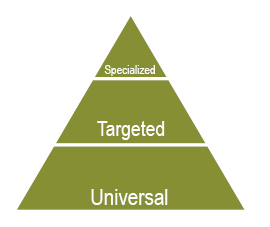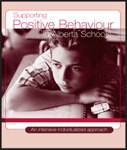
|
Universal Supports benefit all students
- Create an understanding about what anxiety is through class discussion, brainstorming and examples from literature.
- Help students use reframing to change their perception of situations that may typically cause them anxiety.
- Teach anxiety management strategies that students can use when they begin to feel anxious, such as:
- using positive visualization prior to a difficult activity or situation
- recognizing stress in their bodies and taking time to calm down
- using self-talk to calm themselves down (e.g., "I am calm" or counting to 10).
- Teach, practise and review strategies related to managing anxiety at beginning of school year and throughout potentially stressful times of the year (e.g., holidays, exam time).
- Set up a safe place in the classroom where individual students can go to calm down, think about choices and, if needed, make a plan before rejoining the group.
- Post visual reminders of
strategies for reframing and managing anxiety. When appropriate,
collaborate with students to develop these visual reminders.
- Teach and reinforce problem-solving strategies.
- Use descriptive feedback to reinforce individual students when they demonstrate effective strategies for managing anxiety.
|
|

|
Targeted Supports benefit students with more specific needs
- Pair individual students with positive peers who can serve as role models and provide support during potential anxiety-producing situations. Rotate these peers at regular intervals throughout the school year.
- Provide proximity by positioning yourself nearby individual students who may require support and encouragement during potential anxiety-producing situations.
- Intersperse activities in which students experience success with activities that may be anxiety-producing to give students opportunities to calm down and gain control over their anxiety.
- Work with individual students to develop low-key cues and prompts that you can use to remind them to use their anxiety management strategies.
- Create multiple opportunities for movement throughout the school day to help students deal with the physical effects of anxiety. Movement can be a stress reliever for many individuals.
Work with individual students to identify potential situations that cause anxiety and put strategies in place to help to alleviate or reduce anxiety.
- For students who require increased structure and reassurance, develop and review social stories describing how to manage typical situations that may cause them anxiety.
- Use role-play to practise responses to situations that students identify as anxiety producing.
- Develop self-monitoring strategies for students to reflect on and keep track of how they manage anxiety throughout the school day.
- Set up a systematic approach to reinforcement for students who are working on managing their anxiety and related behaviour.
|
Parents know their children well and can offer insights on how to support
their social and emotional well-being. There is strength in collaborating
on strategies that could be used at home, at school and in the community.
|

|
Specialized Supports benefit the small number of students with sensory, physical, cognitive or behavioural needs that require intensive, individualized interventions
- Consider time-limited participation for specific activities that trigger intense anxiety for an individual student. They may benefit from participating in part of the activity and, if possible, gradually increase the participation time throughout the school year.
- Develop an individual behaviour support plan focused on managing anxiety that could include reinforcement strategies. Collaborate with the student's family and other community service providers to develop supports and strategies for the student.
|
|








